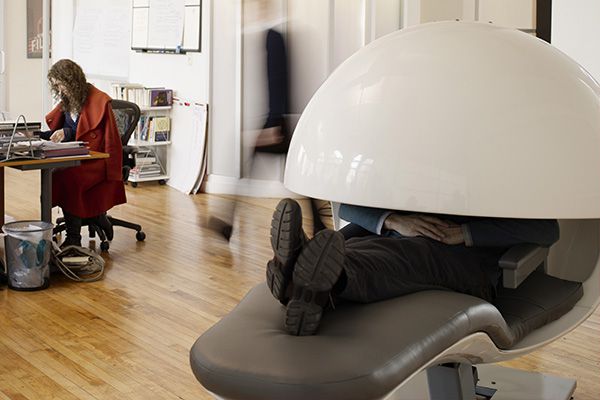Poor sleeping affects organisational performance like no other health issue.

Looking sleep square in the heavy-lidded eye, the country’s first Welnis SleepFit program addresses wellness at design stage, bringing happiness back to the worker and health back to the business.
Big business is about to get a serious wake-up call. Research collated by sleep specialists, SleepFit, has found one in three Australians are experiencing significant sleep problems per year (1). That means one third of any business’ workforce may not be showing up to work, or at least underperforming day-to-day, due to fatigue. It’s a surprising statistic and a very real problem, given that ‘fatigue’ is considered a pretty poor excuse for absenteeism or lack of productivity.
The relationship between performance and sleep is so inextricably connected that when an employee suffers sleep deprivation so too does their efficiency, their safety, and the output of their organisation. In a recent study by Ron Kessler of the Harvard Medical School, sleep disorders trump back and neck problems, depression, and fatigue as causes for absenteeism and presenteeism, costing businesses more than twice as much as anxiety, and eight times as much as heart disease amongst their staff. (2)
With all this staggering data staring us in the face, it is clear that intervening in sleep disorders can increase Australia’s workforce productivity significantly. But how can the design industry step in and play a pivotal role?
With sleep taking out the number one position in contributing to lost working hours, watchwords like ‘wellbeing’ or ‘human-centric’ are increasingly on the tip of clients’ tongues at design brief consultations.
At the forefront of this movement are organisations such as SleepFit and Welnis, specialising in sleep solutions and healthy human interiors – respectively. According to Melissa Webster, CEO of SleepFit, both designers and clients experience untoward frustration trying to combat sleep problems. Due largely to the manner by which access to, and opportunity for, help sits in the hands of major suppliers, those seeking treatment and design answers for sleep disorders are “pushed down a pathway” of shady commerce.
Thinking holistically and, most importantly, putting the individual and their needs first and foremost is paramount for SleepFit. Supporting the fight to “restore, recharge, revitalise”, SleepFit has grown out of the frustration that only 10-15 per cent of sufferers are getting the help they need for sleep disorders. Highly treatable, highly desired – and now, highly financed by top-scale corporates – significant improvements in quality of life (for patients) and significant grounds in recouped revenue (for organisations) can be achieved within weeks of commencing treatment.
With treatment holding the power to transform organisations, trailblazers like Google, PWC, The Huffington Post and Uber have got the memo and looked to sleep experts and the design community for a combined approach of awareness, education, and environment as a complete fatigue management solution.
From the perspective of Welnis, a Sydney-based company specialising in creating healthy human interiors, “it’s really for us to empower the design community, so they can empower their clients”, says founder, Nigel Hobbs.
Teaming up with SleepFit, Welnis has pioneered the country’s first Welnis SleepFit program for architecture and design clients. Combining up-to-the-minute medical expertise with technology-enabled delivery, Welnis SleepFit makes it easier and faster to assess and treat employee sleep problems. From recharge spaces, to quiet spaces, wellness hubs and nap pods, Welnis SleepFit opens the discussion, offering a staggering educational program that reorients user-experience of space to “recharge and use energy in positive ways”.
Futuristic and nifty as it may sound, sleeping fit and staying fit on the job goes far beyond a simple sleep pod. “We come in from the solutions-best angle [to] provide napping facilities, quiet spaces, acoustic scenarios all the way through to acoustic seating,” says Hobbs. Coupled with SleepFit’s awareness campaign which programs sleep assessment with personalised feedback and advice in an anytime/anywhere format, the Welnis SleepFit process is pointedly adored by clients for offering aggregated wellness. This includes reporting back to an organisation in a loop that simultaneously offers real-time treatment covering design answers for ergonomics, acoustics, light and air quality, water purification, fatigue management, nutrition, fitness, stress reduction and environmental balance.
“This process significantly reduces the barrier to full diagnosis of sleep issues as it shortens a traditionally very long, complicated and costly discovery stage for an individual, giving almost ‘instant’ feedback on risk,” comments Webster.
1. Medical and Socio-Professional Impact of Insomnia – Leger et al, Sleep (2002)
2. Harvard Health Publications, Harvard Medical Sleep: “Sleep Problems, Heart Disease Often in Bed Together”
A searchable and comprehensive guide for specifying leading products and their suppliers
Keep up to date with the latest and greatest from our industry BFF's!

Elevate any space with statement lighting to illuminate and inspire.

BLANCOCULINA-S II Sensor promotes water efficiency and reduces waste, representing a leap forward in faucet technology.

In this candid interview, the culinary mastermind behind Singapore’s Nouri and Appetite talks about food as an act of human connection that transcends borders and accolades, the crucial role of technology in preserving its unifying power, and finding a kindred spirit in Gaggenau’s reverence for tradition and relentless pursuit of innovation.

We remember the life and work of Nigel Hobbs, a true visionary and advocate for workplace wellness through design in Australia.

Businesses are finally understanding how precious employees’ health is, and the design industry needs expert consultants to deliver projects that meet these expectations. Welnis shares its 10 key wellness elements for human-centric wellbeing in the built environment.
The internet never sleeps! Here's the stuff you might have missed

In this New Zealand workplace design by Wingates, Anthony Harper were “keen to evolve their working environment as the world evolves as well.”

Outdoor living has always been a hallmark of the Australian way of life. With a demanding climate, outdoor furniture needs to be high-performing – something Dutoit’s TUIN range, available through Australian Design & Co, delivers in spades.